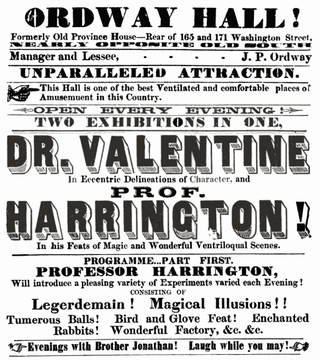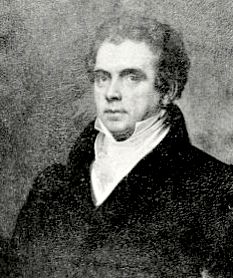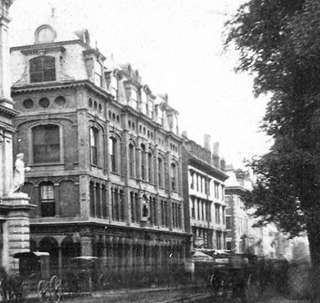
James Ambrose Cutting (1814–1867) was an American photographer and inventor, sometimes called the inventor of the Ambrotype photographic process.

State Street is one of the oldest and most historic streets in Boston, Massachusetts, United States. Located in the financial district, it is the site of some historic landmarks, such as Long Wharf, the Old State House and the Boston Custom House.

The Boston Museum (1841–1903), also called the Boston Museum and Gallery of Fine Arts, was a theatre, wax museum, natural history museum, zoo, and art museum in 19th-century Boston, Massachusetts. Moses Kimball established the enterprise in 1841.

The Melodeon was a concert hall and performance space in 19th-century Boston, Massachusetts, located on Washington Street, near West Street. Musical concerts, lectures, sermons, conferences, visual displays, and popular entertainments occurred there.

Josiah Johnson Hawes (1808–1901) was a photographer in Boston, Massachusetts. He and Albert Southworth established the photography studio of Southworth & Hawes, which produced numerous portraits of exceptional quality in the 1840s–1860s.

Dock Square in downtown Boston, Massachusetts, is a public square adjacent to Faneuil Hall, bounded by Congress Street, North Street, and the steps of the 60 State Street office tower. Its name derives from its original (17th-century) location at the waterfront. From the 1630s through the early 19th century, it served boats in the Boston Harbor as "the common landing place, at Bendell's Cove," later called Town Dock. "Around the dock was transacted the chief mercantile business of the town." After the waterfront was filled in during the early 19th century, Dock Square continued as a center of commerce for some years. The addition in the 1960s of Government Center changed the scale and character of the square from a hub of city life, to a place one merely passes through. As of the 1950s the square has become largely a tourist spot, with the Freedom Trail running through it. John Winthrop, coming from Salem where he landed as a Puritan from England, ended up "setting up a dock at the head of the cove, and here began the town of Boston, which soon was recognized as the political and economic center of the [Massachusetts Bay] colony.

Merchants Row in Boston, Massachusetts, is a short street extending from State Street to Faneuil Hall Square in the Financial District. Since the 17th century, it has been a place of commercial activity. It sits close to Long Wharf and Dock Square, hubs of shipping and trade through the 19th century. Portions of the street were formerly known as Swing-Bridge Lane, Fish Lane, and Roebuck Passage.

Ordway Hall (est.1852) was a theatre in Boston, Massachusetts located off Washington Street in the former Province House. John P. Ordway established and managed the hall, which specialized in "negro minstrelsy," particularly the Ordway Aeolians, his own troupe.
The Boston Aquarial and Zoological Gardens in Boston, Massachusetts, featured a public aquarium and zoo. It was located in the Financial District on Central Court. On display were "hundreds of specimens of the finny tribe there to be seen sporting in their native element, in all their variety of hue and shape" as well as other animals. James Ambrose Cutting and Henry D. Butler ran the business, derived from an earlier incarnation known as the Boston Aquarial Gardens.P.T. Barnum bought it in 1862, renovated it, and reopened it as Barnum's Aquarial Gardens.

Doggett's Repository of Arts was an art gallery in Boston, Massachusetts, United States, located at 16 Market Street. Its proprietor, John Doggett, was a gilder and framer with a retail shop near the gallery. The gallery exhibited originals and copies of works by European masters such as Titian, Rembrandt, Watteau, and David, and a few American artists, such as Thomas Sully, Gilbert Stuart, Samuel F.B. Morse, Rembrandt Peale, and William Dunlap. By July 1825, the gallery was converted into retail space for Doggett's frame, mirror and carpet business.

Frost & Adams (est.1869) was an artists' supply firm in Boston, Massachusetts, located in Cornhill, on the current site of Boston City Hall and City Hall Plaza. It began in 1869 when artist Francis Seth Frost and retailer E.H. Adams bought the business of Matthew J. Whipple. By the 1880s Frost & Adams were "the chief dealers in artists' materials in New England."
Julien Hall was a building in Boston, Massachusetts, on the corner of Congress Street and Milk Street. It flourished 1825-1843, housing a variety of public events such as lectures by Red Jacket, William Lloyd Garrison; temperance meetings; political meetings; auctions; exhibitions of live animals, portraits by William James Hubard, John H. I. Browere; performances of the "automaton chess player" and the "panharmonicon;" and so on. By 1842 boxer John Sheridan had converted space in the hall into an athletic gymnasium.

The Studio Building (1861–1906) on Tremont Street in Boston, Massachusetts, housed artists' studios, theater companies and other businesses in the 19th century. It "held the true Bohemia of Boston, where artists and literati delighted to gather." Among the tenants were portraitist E.T. Billings, architect George Snell, sculptor Martin Milmore, artists William Morris Hunt, William Rimmer, Edward Mitchell Bannister, Phoebe Jenks; gallerist Seth Morton Vose, and many others.

Tremont Row (1830s-1920s) in Boston, Massachusetts, was a short street that flourished in the 19th and early-20th centuries. It was located near the intersection of Court, Tremont, and Cambridge streets, in today's Government Center area. It existed until the 1920s, when it became known as Scollay Square. In 1859 the Barre Gazette newspaper described Tremont Row as "the great Dry Goods Street of Boston."
Theatre Comique (1865–1869) of Boston, Massachusetts, was located at no. 240 Washington Street. Personnel included Jason Wentworth, William H. Crisp, James S. Maffitt, George Maffitt, B.F. Lowell, Wm. H. Daly, orchestra leader Aug. Muller, and maitre de ballet Signor Constantine. Among the performances: slack rope and acrobatics by Martini Chiriski and the Levantine Brothers; Mlle. Augusta, danseuse; "Aladdin" with Kate Pennoyer and W.H. Bartholomew; dancing by Betty Regl; Snow Brothers ; Morlacchi Ballet Troupe; Wilson Brothers ; Ada Harland; and Jarrett & Palmer's "Forty Thieves." It occupied the building formerly known as Andrews Hall, Barnum's Aquarial Gardens, and the Boston Aquarial and Zoological Gardens. In 1869 the theatre was renamed the "Adelphi Theatre."
The Palace Theatre (ca.1891-1931) of Boston, Massachusetts, United States, was a variety theatre on Court Street in the late 19th and early 20th centuries. Acts which performed there included Rose Hill Folly Co., Clifford & Dixon, Murry & Murry, Behler & Stone, and the Adamless Eden Burlesquers. It also showed photo-plays such as The Exploits of Elaine, The Master Key, and "Charles Chaplin comedies." Among its managers and proprietors were William Austin, F. J. Pilling, George Milbank, and Dunn & Waldron. The Palace occupied the building of the former Nickelodeon. It existed until 1931, when it was demolished.

Horticultural Hall (1865–1901) of Boston, Massachusetts, was the headquarters of the Massachusetts Horticultural Society in the later 19th century. It stood at no.100-102 Tremont Street, at the corner of Bromfield Street, opposite the Granary Burying Ground. Architects Gridley J.F. Bryant and Arthur Gilman designed the building. Sculptor Martin Milmore created horticulturally-themed statuary for the building's exterior: "three ancient Roman goddesses ... Ceres, goddess of agriculture; Flora, goddess of flowers; and Pomona, goddess of fruit trees." In the 1880s: "the ground floor [was] occupied by stores; the second story by the Library Room of the society and a hall for the weekly exhibitions; and the upper story by a large and elegant hall used ... at the annual and other important exhibitions. Both of these halls [were] often used for concerts and the better class of entertainments. The society's library, comprising over 4,000 volumes, [was] the most valuable collection of horticultural works in the United States. The halls [were] adorned with portraits and busts of the presidents, founders, and benefactors of the society."

The Wesleyan Building (est.1870) of Boston, Massachusetts, is located on Bromfield Street in the vicinity of Downtown Crossing. Architects Joseph Billings and Hammatt Billings designed it as the headquarters of the Methodist Boston Wesleyan Association. Tenants have included the New-England Methodist Historical Society; Zion's Herald; Woman's Foreign Missionary Society of the Methodist Episcopal Church; Boston Lyceum Bureau; Boston Theological Seminary; Boston University School of Law; Emerson College of Oratory; and Hudl. By 1912 the Methodists had moved to a new building on Copley Square.

The South Boston Aquarium was a public aquarium in Boston, Massachusetts.




















